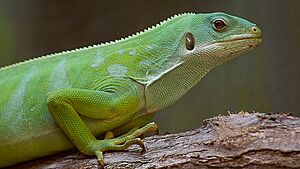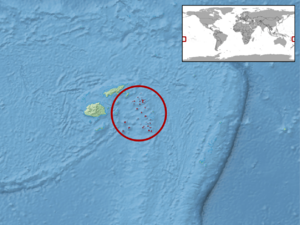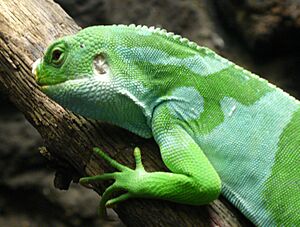Lau banded iguana facts for kids
Quick facts for kids Lau banded iguana |
|
|---|---|
 |
|
| Lau banded iguana in captivity | |
| Conservation status | |
| Scientific classification | |
| Genus: |
Brachylophus
|
| Species: |
fasciatus
|
 |
|
The Brachylophus fasciatus, also known as the Lau banded iguana, is a special type of lizard that lives mostly in trees. It is found only in the Lau Islands in the eastern part of Fiji. You can also find it in Tonga, but it was probably brought there by people a long time ago.
This iguana is one of the few types of iguanas that live outside of North and South America. It is also one of the most isolated members of its family, meaning it lives very far away from its closest relatives. Sadly, the number of these iguanas has been going down. This is because their homes are being destroyed and new animals like mongooses and house cats have been brought to the islands. These new animals hunt the iguanas.
Lau banded iguanas are active during the day. They spend their time looking for food, warming themselves in the sun, and watching over their areas. At night, they go back up into the treetops to sleep. The government of Fiji sees these iguanas as a national treasure. You can even see their pictures on postage stamps, money, and phone book covers!
Contents
About the Lau Banded Iguana
What's in a Name?
A French zoologist named Alexandre Brongniart first described this iguana in 1800. The name Brachylophus comes from two Greek words: brachys, meaning "short," and lophos, meaning "crest" or "plume." This describes the short, spiky crests along the iguana's back. The second part of its name, fasciatus, is a Latin word that means "banded," referring to the stripes on its body.
This iguana is related to other iguanas in the Brachylophus family, like the Fiji crested iguana. Scientists think that the ancestors of these iguanas might have traveled a very long way, about 9,000 kilometers (5,600 miles), across the Pacific Ocean from North or South America. They might have floated on rafts of plants! Their closest relatives are found there. Another idea is that they came from an older group of iguanas that used to live in other parts of the world, but no other iguanas from that group have been found outside Fiji and Tonga.
Where Do They Live?
The Lau banded iguana is native to the Lau Islands in Fiji. Its home range stretches from Vanua Balavu in the north to Fulaga and Ogea in the south. This includes at least eleven different islands. In the past, they were also seen on Moce and Oneata. They might have once lived all over the Lau group of islands.
About 300 years ago, these iguanas were brought to the Tonga Islands. This probably happened after another type of native iguana, Brachylophus gibbonsi, became extinct there.
What Do They Look Like?
Male and female Lau banded iguanas look different from each other. This is called being sexually dimorphic.
- Males are a bright emerald green. They have two or three white or light blue bands, about 2 centimeters (0.8 inches) wide, across their bodies. They also have spots and stripes on their necks.
- Females are usually solid green. They might have a few spots or partial bands, but not the clear bands like the males.
Both male and female iguanas have yellow undersides. These iguanas can grow up to 60 centimeters (24 inches) long, from their snout to the tip of their tail. They can weigh up to 200 grams (0.44 pounds). The crests along their backs are very short, only about 0.5 centimeters (0.2 inches) long.
The skin of the Lau banded iguana is special because it is sensitive to light. This means the lizard can change its skin color to blend in with its surroundings. Some iguanas in zoos have even been seen changing their color to match the pattern of the screen on top of their cages in just 30 seconds!
How Do They Behave?
Lau banded iguanas are active during the day. They spend their days looking for food, warming up in the sun, and watching over their areas. At night, they climb into the treetops to sleep safely.
Male iguanas use their sight a lot. They are very protective of their territories and will fight with other males who try to enter. When a male iguana wants to show off or scare another male, it will make its green color deeper and its bands brighter. It will also bob its head and lunge at intruders with its mouth open. They often puff out their dewlaps (the flap of skin under their chin) to look bigger. Sometimes, these displays can lead to fierce fights between males.
What Do They Eat?
Fiji banded iguanas are herbivorous, which means they only eat plants. They munch on the leaves, fruits, and flowers of trees and bushes. They especially love the hibiscus flowers from the Vau tree (Hibiscus tiliaceus) and fruits like banana and papaya. Baby iguanas in captivity have been seen eating insects, but adult iguanas usually do not.
Reproduction and Life Cycle
The way Lau banded iguanas find a mate is similar to other iguanas. The male will approach the female, bob his head quickly, and then flick his tongue on her back, front legs, and neck. The breeding season for these iguanas is in November.
The Fiji banded iguana lays eggs, which is called being oviparous. Their eggs take a long time to hatch, about 160 to 170 days. Females usually lay three to six eggs. What's interesting is that female iguanas guard their nests, which is not common for many other types of iguanas. The baby iguanas hatch from their eggs during the rainy season. They get the water they need by licking wet leaves.
Iguanas and People
Folklore and Stories
In Fiji, the name for iguana is "vokai." However, some tribes call it "saumuri." Two tribes consider the iguana their totem animal. This means they believe the iguana is a special symbol for their tribe. Because of this, they are not allowed to say the iguana's name when women are around. If someone breaks this rule, they might get hit with a stick!
Most Fijians, though, are actually scared of iguanas. This is because of how the iguanas act when they feel threatened. When an iguana is scared, it turns black, opens its mouth wide, and lunges at whatever is bothering it.
Threats to the Iguanas
The biggest dangers to the Lau banded iguana are things that destroy their homes. These include fires, big storms, and land being cleared for farming. They also have to compete with wild goats for food.
Another big problem is new animals that have been brought to the islands. Rats, mongooses, and cats hunt the iguanas and eat their eggs. Sadly, iguanas have also been hunted by people for food and for the illegal pet trade.
Iguanas in Zoos
Since 1982, the Fijian government has said that almost all Lau banded iguanas in zoos around the world were taken illegally from Fiji. They believe that most of the 50 to 100 banded iguanas in American zoos were obtained without Fiji's permission. However, the San Diego Zoo has been very successful in breeding Lau banded iguanas. They have the most successful breeding group of these iguanas in the world.
Images for kids




